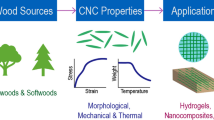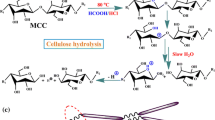Abstract
Cellulose nanocrystals (CNC) have recently received much attention in the global scientific community for their unique mechanical and optical properties. Here, we conducted the first detailed exploration of the basic properties of CNC, such as morphology, crystallinity, degree of sulfation and yield, as a function of production condition variables. The rapid cellulose depolymerization and sulfation reactions under concentrated acid concentrations of around 60 wt% resulted in a very narrow operating window for CNC production. We found that CNC yields as high as 70 wt% from a bleached eucalyptus kraft pulp with glucan content of 78 wt% can be achieved under a tight range of reaction conditions and that a weighted average length of over 200 nm and sulfur content (a measure of CNC surface charge) between 3 and 10 mg/g can be produced. This study provided critical knowledge for the production of CNC with characteristics tailored for different specific applications, significant to commercialization.





Similar content being viewed by others
References
Agarwal UP, Reiner RS, Ralph SA (2010) Celulose I crystallinity determination using FT-Raman spectroscopy: univariate and multivariate methods. Cellulose 17(4):721–733
Araki J, Wada M, Kuga S, Okano T (1998) Flow properties of microcrystalline cellulose suspension prepared by acid treatment of native cellulose. Colloids Surf A 142:75–82
Beck S, Bouchard J, Berry R (2011) Controlling the reflection wavelength of iridescent solid films of nanocrystalline cellulose. Biomacromolecules 12(1):167–172
Beck-Candanedo S, Roman M, Gray DG (2005) Effect of reaction conditions on the properties and behavior of wood cellulose nanocrystal suspensions. Biomacromolecules 6:1048–1054
Biyani MV, Foster EJ, Weder C (2013) Light-healable supramolecular nanocomposites based on modified cellulose nanocrystals. ACS Macro Lett 2(3):236–240
Bondeson D, Mathew A, Oksman K (2006) Optimization of the isolation of manocrystals from microcrystalline cellulose by acid hydrolysis. Cellulose 13:171–180
Camarero Espinosa S, Kuhnt T, Foster EJ, Weder C (2013) Isolation of thermally stable cellulose nanocrystals by phosphoric acid hydrolysis. Biomacromolecules 14(4):1223–1230
Capadona JR, Shanmuganathan K, Tyler DJ, Rowan SJ, Weder C (2008) Stimuli-responsive polymer nanocomposites inspired by the sea cucumber dermis. Science 319(5868):1370–1374
Chen Y, Liu C, Chang PR, Cao X, Anderson DP (2009) Bionanocomposites based on pea starch and cellulose nanowhiskers hydrolyzed from pea hull fibre: effect of hydrolysis time. Carbohydr Polym 76(4):607–615
Coulibaly S, Roulin A, Balog S, Biyani MV, Foster EJ, Rowan SJ, Fiore GL, Weder C (2014) Reinforcement of optically healable supramolecular polymers with cellulose nanocrystals. Macromolecules 47(1):152–160
Davis MW (1998) A rapid modified method for compositional carbohydrate analysis of lignocellulosics by high pH anion-exchange chromatography with pulsed amperometric detection (HPAEC/PAD). J Wood Chem Technol 18(2):235–352
Dong XM, Gray DG (1997) Induced circular dichroism of isotropic and magnetically-oriented chiral nematic suspensions of cellulose crystallites. Langmuir 13(11):3029–3034
Dong XM, Revol JF, Gray DG (1998) Effect of microcrystallite preparation conditions on the formation of colloid crystals of cellulose. Cellulose 5:19–32
Habibi Y, Lucia LA, Rojas OJ (2010) Cellulose nanocrystals: chemistry, self-assembly, and applications. Chem Rev 110(6):3479–3500
Hamad WY, Hu TQ (2010) Structure–process–yield interrelations in nanocrystalline cellulose extraction. Can J Chem Eng 88:392–402
Hsu L, Weder C, Rowan SJ (2011) Stimuli-responsive, mechanically-adaptive polymer nanocomposites. J Mater Chem 21(9):2812–2822
Kargarzadeh H, Ahmad I, Abdullah I, Dufresne A, Zainudin SY, Sheltami RM (2012) Effects of hydrolysis conditions on the morphology, crystallinity, and thermal stability of cellulose nanocrystals extracted from kenaf bast fibers. Cellulose 19(3):855–866
Kelly JA, Shukaliak AM, Cheung CCY, Shopsowitz KE, Hamad WY, MacLachlan MJ (2013) Responsive photonic hydrogels based on nanocrystalline cellulose. Angew Chem Int Ed 52(34):8912–8916
Luo X, Gleisner R, Tian S, Negron J, Horn E, Pan XJ, Zhu JY (2010) Evaluation of mountain beetle infested lodgepole pine for cellulosic ethanol production by SPORL pretreatment. Ind Eng Chem Res 49(17):8258–8266
Marchessault RH, Morehead FF, Koch MJ (1961) Some hydrodynamic properties of neutral suspensions of cellulose crystallites as realted to size and shape. J Colloid Sci 16:327–344
Mukherjee SM, Woods HJ (1953) X-ray and electron microscope studies of the degradation of cellulose by sulphuric acid. Biochim Biophys Acta 10:499–511
Park S, Baker JO, Himmel ME, Parilla PA, Johnson DK (2010) Ceseealrlcuh lose crystallinity index: measurement techniques and their impact on interpreting cellulase performance. Biotechnol Biofuels 3:10
Potter KA, Jorfi M, Householder KT, Foster EJ, Weder C, Capadona JR (2014) Curcumin-releasing mechanically adaptive intracortical implants improve the proximal neuronal density and blood-brain barrier stability. Acta Biomater 10(5):2209–2222
Revol J-F, Godbout DL, Gray DG; Pulp and Paper Research Institute of Canada, assignee (1997) Solidified liquid crystals of cellulose with optically variable properties. US Patent 5, 629, 055
Revol J-F, Godbout L, Dong X-M, Gray DG, Chanzy H, Maret G (1994) Chiral nematic suspensions of cellulose crystallites; phase separation and magnetic field orientation. Liq Cryst 16:127–134
Segal L, Creely JJ, Martin AE, Conrad CM (1959) An empirical method for estimating the degree of crystallinity of native cellulose using the X-ray diffractometer. Text Res J 29:786–794
Šturcová A, Davies GR, Eichhorn SJ (2005) Elastic modulus and stress-transfer properties of tunicate cellulose whiskers. Biomacromolecules 6(2):1055–1061
Wang QQ, Zhu JY, Reiner RS, Verrill SP, Baxa U, McNeil SE (2012) Approaching zero cellulose loss in cellulose nanocrystal (CNC) production: recovery and characterization of cellulosic solid residues (CSR) and CNC. Cellulose 19(6):2033–2047
Wang Q, Zhao X, Zhu JY (2014) Kinetics of strong acid hydrolysis of a bleached kraft pulp for producing cellulose nanocrystals (CNCs). Ind Eng Chem Res 53(27):11007–11014
Xu X, Wang H, Jiang L, Wang X, Payne SA, Zhu JY, Li R (2014) Comparison between cellulose nanocrystal and cellulose nanofibril reinforced poly(ethylene oxide) nanofibers and their novel shish-kebab-like crystalline structures. Macromolecules 47(10):3409–3416
Yu H, Qin Z, Liang B, Liu N, Zhou Z, Chen L (2013) Facile extraction of thermally stable cellulose nanocrystals with a high yield of 93 % through hydrochloric acid hydrolysis under hydrothermal conditions. J Mater Chem A 1(12):3938–3944
Zhou Y, Fuentes-Hernandez C, Khan TM, Liu JC, Hsu J, Shim JW, Dindar A, Youngblood JP, Moon RJ, Kippelen B (2013) Recyclable organic solar cells on cellulose nanocrystal substrates. Sci Rep 3:1536
Acknowledgments
This work was conducted while Chen and Wang were visiting Ph.D students at the US Forest Service, Forest Products Laboratory (FPL), Madison, WI, and on official government time of Zhu, Baez, and Hirth. This work was supported by US Forest Service. Financial support included the USDA Agriculture and Food Research Initiative (AFRI) Competitive Grant (No. 2011-67009-20056), Chinese Scholarship Council (CSC), Guangzhou Elite Project of China. Funding from these programs made the visiting appointments of Chen and Wang at FPL possible. We also would like to acknowledge Drs. Ulrich Baxa of Nanotechnology Characterization Laboratory, Frederick National Laboratory for Cancer Research and Robin Harris of Johannes Gutenberg-University, Germany, for their insightful discussion on TEM images.
Author information
Authors and Affiliations
Corresponding author
Additional information
This work was conducted on official government time of Zhu, Hirth, Baez, and Agarwal and while Chen and Wang were visiting students at the USDA Forest Products Lab.
Electronic supplementary material
Below is the link to the electronic supplementary material.
Rights and permissions
About this article
Cite this article
Chen, L., Wang, Q., Hirth, K. et al. Tailoring the yield and characteristics of wood cellulose nanocrystals (CNC) using concentrated acid hydrolysis. Cellulose 22, 1753–1762 (2015). https://doi.org/10.1007/s10570-015-0615-1
Received:
Accepted:
Published:
Issue Date:
DOI: https://doi.org/10.1007/s10570-015-0615-1




